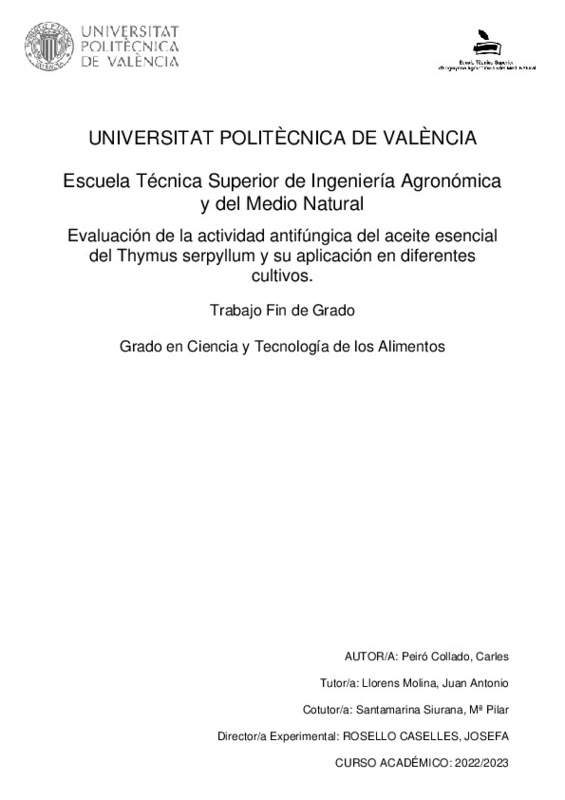JavaScript is disabled for your browser. Some features of this site may not work without it.
Buscar en RiuNet
Listar
Mi cuenta
Estadísticas
Ayuda RiuNet
Admin. UPV
Evaluación de la actividad antifúngica del aceite esencial del Thymus serpyllum y su aplicación en diferentes cultivos.
Mostrar el registro sencillo del ítem
Ficheros en el ítem
| dc.contributor.advisor | Llorens Molina, Juan Antonio
|
es_ES |
| dc.contributor.advisor | Santamarina Siurana, Mª Pilar
|
es_ES |
| dc.contributor.advisor | Rosello Caselles, Josefa
|
es_ES |
| dc.contributor.author | Peiró Collado, Carles
|
es_ES |
| dc.date.accessioned | 2023-09-14T14:01:46Z | |
| dc.date.available | 2023-09-14T14:01:46Z | |
| dc.date.created | 2023-07-27 | |
| dc.date.issued | 2023-09-14 | es_ES |
| dc.identifier.uri | http://hdl.handle.net/10251/196476 | |
| dc.description.abstract | [ES] La contaminación fúngica es un problema grave en la gran mayoría de cultivos. Esta provoca pérdidas de productividad y calidad del producto, lo que se transfiere en una gran pérdida económica. Se sabe que los aceites esenciales de diferentes plantas aromáticas poseen propiedades antifúngicas y antimicrobianas e incluso medicinales. Es por ello por lo que son muy interesantes como recambio de productos de síntesis química tales como pesticidas. En el siguiente estudio se analiza la composición química del aceite esencial comercial Thymus serpyllum y su actividad antifúngica frente a diferentes hongos fitopatógenos, causantes de enfermedades en las plantas y del deterioro de los productos agrícolas en cultivo y de los alimentos, como son Alternaria alternata, Botrytis cinerea, Curvularia hawaiiensis, Fusarium equiseti, Fusarium oxysporum lycopersici, Rhizoctonia solani y Verticillium dahliae. El análisis de la composición química se realizó mediante cromatografía de gases (GC) y cromatografía de gases acoplada a espectrometría de masas (GC-MS). La actividad antifúngica in vitro de los aceites esenciales se ha evaluado siguiendo la metodología de Singh et al. (2008) modificada, realizando diferentes ensayos para conocer la inhibición del crecimiento miceliar de los hongos. Los primeros resultados del estudio realizado muestran la presencia de compuestos de conocida actividad antifúngica, concretamente compuestos fenólicos como timol y carvacrol, dos compuestos con propiedades fungicidas ampliamente conocidas. En este estudio se pone de manifiesto el gran potencial del aceite esencial de Thymus serpyllum como una clara alternativa para el tratamiento de los hongos fitopatógenos en cultivos y de esta manera poder alargar la vida útil de los productos agrícolas. | es_ES |
| dc.description.abstract | [EN] Fungal contamination is a serious problem in the vast majority of crops. It causes productivity and product quality losses, resulting in significant economic losses. It is known that essential oils from different aromatic plants possess antifungal, antimicrobial, and even medicinal properties. For this reason, they are highly interesting as an alternative to chemically synthesized products. This study analyzes the chemical composition of the commercial essential oil of Thymus serpyllum and its antifungal activity against different phytopathogenic fungi, which cause diseases in plants and deterioration of agricultural and food products. The fungi studied include Alternaria alternata, Bipolaris spicifera, Curvularia hawaiiensis, Fusarium oxysporum sp lycopersici y Penicillium italicum. The analysis of the chemical composition was performed using gas chromatography-mass spectrometry (GC-MS) for component identification and flame ionization detection (FID) for approximate quantification. The in vitro antifungal activity of the essential oils was evaluated following the modified methodology of Singh et al. (2008). Consequently, several laboratory tests were conducted with the essential oil of Thymus serpyllum to determine the miceliar grade of inhibition (MIG) against the aforementioned fungi. The initial results of the study show the presence of compounds with known antifungal activity, specifically phenolic compounds such as thymol and carvacrol, two widely recognized fungicidal compounds. This study highlights the great potential of Thymus serpyllum essential oil as a clear alternative for the treatment of phytopathogenic fungi in crops, thus extending the shelf life of agricultural products. | es_ES |
| dc.format.extent | 48 | es_ES |
| dc.language | Español | es_ES |
| dc.publisher | Universitat Politècnica de València | es_ES |
| dc.rights | Reserva de todos los derechos | es_ES |
| dc.subject | Actividad antifúngica | es_ES |
| dc.subject | Aceite esencial | es_ES |
| dc.subject | Thymus serpyllum | es_ES |
| dc.subject | Hongos | es_ES |
| dc.subject | Essential oil | es_ES |
| dc.subject | Contamination | es_ES |
| dc.subject | Chemical composition | es_ES |
| dc.subject.classification | QUIMICA ANALITICA | es_ES |
| dc.subject.classification | BOTANICA | es_ES |
| dc.subject.other | Grado en Ciencia y Tecnología de los Alimentos-Grau en Ciència i Tecnologia dels Aliments | es_ES |
| dc.title | Evaluación de la actividad antifúngica del aceite esencial del Thymus serpyllum y su aplicación en diferentes cultivos. | es_ES |
| dc.title.alternative | Evaluation of the antifungal activity of Thymus serpyllum essential oil and its application in different crops. | es_ES |
| dc.title.alternative | Avaluació de l'activitat antifùngica de l'oli essencial de Thymus serpyllum i la seua aplicació en diferents cultius | es_ES |
| dc.type | Proyecto/Trabajo fin de carrera/grado | es_ES |
| dc.rights.accessRights | Abierto | es_ES |
| dc.contributor.affiliation | Universitat Politècnica de València. Departamento de Química - Departament de Química | es_ES |
| dc.contributor.affiliation | Universitat Politècnica de València. Escuela Técnica Superior de Ingeniería Agronómica y del Medio Natural - Escola Tècnica Superior d'Enginyeria Agronòmica i del Medi Natural | es_ES |
| dc.description.bibliographicCitation | Peiró Collado, C. (2023). Evaluación de la actividad antifúngica del aceite esencial del Thymus serpyllum y su aplicación en diferentes cultivos. Universitat Politècnica de València. http://hdl.handle.net/10251/196476 | es_ES |
| dc.description.accrualMethod | TFGM | es_ES |
| dc.relation.pasarela | TFGM\156944 | es_ES |
Este ítem aparece en la(s) siguiente(s) colección(ones)
-
ETSIAMN - Trabajos académicos [3541]
Escuela Técnica Superior de Ingeniería Agronómica y del Medio Natural






